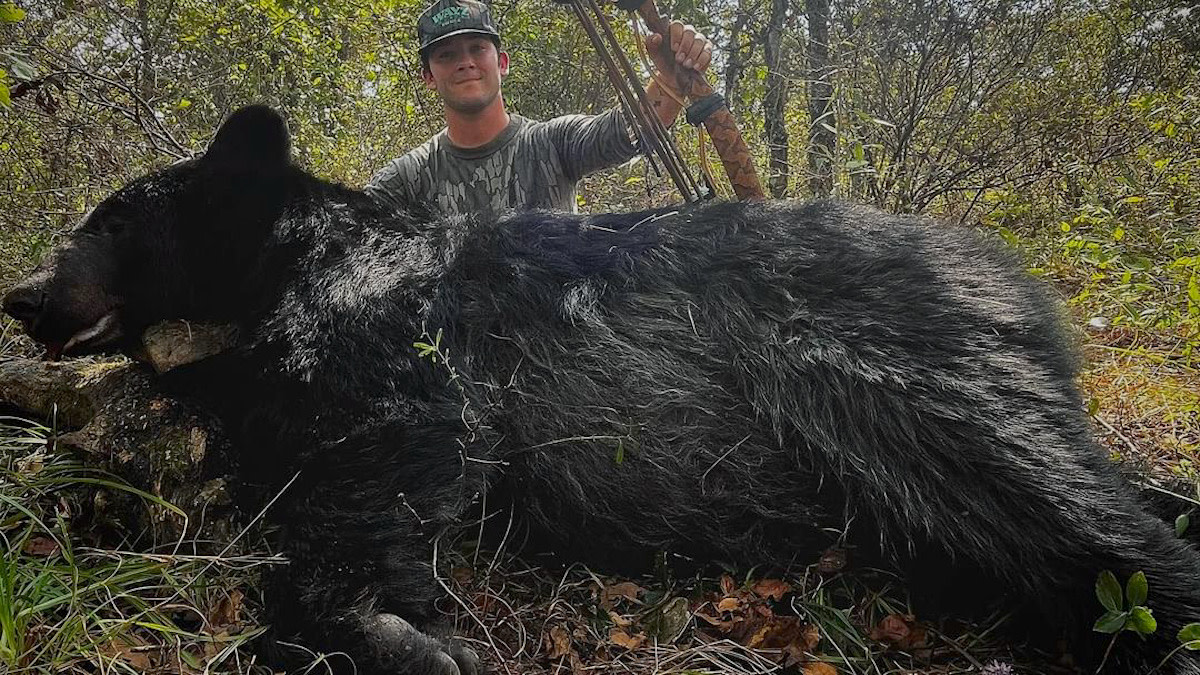Oklahoma Hunter Harvests Black Bear with Stone Point for First Time Since Species Reintroduction

Even for experienced hunters using the most advanced modern rifles or compound bows, harvesting a large black bear is challenging. It involves hours if not days of patience, persistence, and immersion into the lives and habits of one of the continent's largest land predators.
But to do it with a homemade bow–where everything from the bowstring to the broadhead is built from scratch–represents another level of commitment. But that's exactly what 26-year-old Caleb Flies did this year in Oklahoma, and he could be one of the first in recent memory to do it in the Sooner State.

Behind the Bowhunter
Oklahoma-born and raised, Flies found his love for the outdoors alongside his grandpa, finding fulfillment through immersion in the natural world.
“Traditional bows have always been appealing to me, and I’ve shot one my entire life,” he told MeatEater. “Fictional characters like Robinhood or Legolas were the coolest of heroes to me, and as a kid I’d often make crude bows out of saplings, pretending to be those heroes.”
As he got older, Flies shot recurve bows or longbows made from laminated wood or fiberglass, but five years ago he attended a bow-building festival in northern Oklahoma. The Oklahoma Self-Bow Jamboree is put on by the Oklahoma Selfbow Society, and each year instructors lend their expertise to demonstrate how to build a bow.
“After building my own bow, I was hooked,” Flies said. “I still hunt with a recurve and longbow sometimes, but the self-bow has an ever-growing desire to be the bow that goes on adventures with me. And now that passion has culminated in my own archery company, Ravenclaw Archery, to make my passion my profession as well.”
The Bow
The bow for this hunt was remarkably simple, especially compared to the advanced compound bows of today. Flies crafted the bow out of an Osage Orange tree, and the final product was around 55 pounds in draw weight.

He strung it with a flax fiber linen bowstring, backed it with copperhead skins, and wrapped the handle with beaver tail leather. For the finger tab, he used his own Ravenclaw Archery wood tab made from Osage wood, cordovan leather, beaver tail, and copperhead skin. The arrows consisted of Douglas fir shafts from Surewood Shafts fletched with wild turkey feathers.
The broadheads were flint knapped out of obsidian, weighing between 62 and 68 grains each and measuring between ⅞- and 1-inch wide. Flies used hide glue and deer backstrap sinew to attach the stone points to the wood shafts, spinning them to make sure they were mounted straight.
“I chose this setup for two reasons. Firstly, I enjoy the challenge of crafting such primitive weapons, as I believe it gives more meaning to the hunt, to honor the life of the animal,” Flies said. “Having to be so close to the animal before shooting emphasizes the fair chase element of the hunt and makes the interaction more personal and meaningful to me.”

The Hunt
Oklahoma isn’t known as a black bear haven. There were only about 1,300 black bears in the state as of 2020, though that number has likely grown in subsequent years. Finding a bear is challenging, and even though a 55-pound bow has enough power to kill a bear, their keen senses make getting within shooting range a difficult prospect.
To make the task possible, Caleb hid in a high tree stand, waiting over bait for a sizable, legal bear to present itself. With a stroke of luck, on opening day, he got a shot on an old barren sow.
“The shot was perfectly placed, right behind the shoulder. The arrow penetrated through the front ribs, through both lungs and into the far side ribs of this large bear,” Flies said. “The animal did not run 20 yards before falling over and expired within a minute of the shot. I was able to retrieve the obsidian head and it was in great condition except for the corner notches breaking off.”
And this was no small bear, weighing around 300 pounds live weight, and remarkably healthy. All the meat was harvested (as legally required), and the hide and skull were sent to the taxidermist.
“For me it was an incredible achievement, one I had worked on for years,” Flies said.
The Oklahoma Department of Conservation doesn’t break down archery kills into type of bow used, but a spokesperson told MeatEater that Flies may be the first hunter to take a black bear with a stone point since the reintroduction of black bears in the 1960’s. Other Oklahoma hunters have used self-made bows to take black bears, but those hunters used modern steel broadheads.
Regardless, kudos to Caleb for the exceptional craftsmanship, and congratulations on the memorable harvest. If you’d like to watch someone take a bear with a stone point, check out Clay Newcomb’s bear hunt in this episode of the Bear Grease Roadshow.
Images via Caleb Flies.





